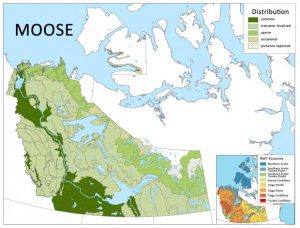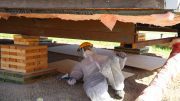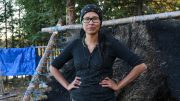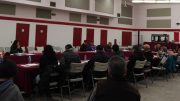It’s the season for moose to be on the move across the Northwest Territories, and for once the territorial government’s numbers and Indigenous traditional knowledge is lining up. The moose population in the Dehcho region is healthy and stable, according the most recent survey from the GNWT’s Department of Environment and Natural Resources, and Dene elders.
ENR has been monitoring moose numbers since 2003, through community-based monitoring programs and aerial surveys. Their last complete survey with results from the communities of Fort Liard, Fort Simpson, Jean Marie River, Nahanni Butte, and Wrigley happened over the winter months of 2017-2018.
So far this fall at least six bulls have been harvested in and around the community Jean Marie River.
“It’s been a good fall hunt for people in our community. Two bulls were harvested by extended family in Hay River. I didn’t even have to call the moose this year, I was driving along and there was a bull. My wife and I are making dry-meat and filling our freezer,” Isadore Simon told CKLB earlier this week.
A large cow was hit by a vehicle near checkpoint, fortunately there was no waste as some hunters were there to harvest the meat before it spoiled. Meanwhile some hunters have not had to go too far from their house to bag their fall hunt.
Community members in SambaaK’e, formerly known as Trout Lake, are out on the land this week for their annual fall hunt. According to staff at the community store, one lucky hunter got a bull moose a few minutes’ walk from their house on the shore line of Trout Lake.
“It’s a difficult time of the year to campaign with most families out on the land trying to get their fall moose,” said Nahendeh MLA candidate Randy Sibbeston.
Butchering a moose
“We bring it home, throw it on the table and butcher it up. We don’t hang it like white men do,” Simon added. But some hunters like Tony Jumbo in SambaaK’e prefer to let their kill sit for up to 15 minutes to prevent the meat from being tough.
Safety concerns
But with successful hunts, there has also been some close calls. Safety issues have been raised by RCMP in the region after a 49-year-old man from Fort Liard was accidentally shot by his relatives this past weekend.
“We are in hunting season and we can’t stress enough the importance to be extremely careful. Make sure you are visible by wearing orange or other safety vest colours. Do not discharge your firearm over a road-way, or from a vehicle. Ensure you have your confirmed target in sight. In general, let others know where you’re going and when you plan to be back. Whether you are bow, crossbow or rifle hunting, do so in a safe and responsible manner. Hunters must have a valid Possession Acquisition Licence (PAL) and the firearm and ammunition must be properly stored,” said Staff Sergeant Ken Beard in a press release. Beard is the South District Advisory NCO.
In his novel, New Brunswick Author David Adams Richards calls moose hunting the most “extravagant.”
“You need equipment to hunt, and a crew. It is hard hunting moose on your own. But in many respects it might be the greatest hunting there is on this land,” writes Adams Richards in his novel Facing the Hunter.
As one elder once told me, “No moose hide, no moccasins, and no dry-meat.”
ENR Communications and Planning Specialist Joslyn Oosenbrug says the next moose survey for the Dehcho is tentatively scheduled for the winter of 2021-2022.

Map and Graph courtesy of ENR.









